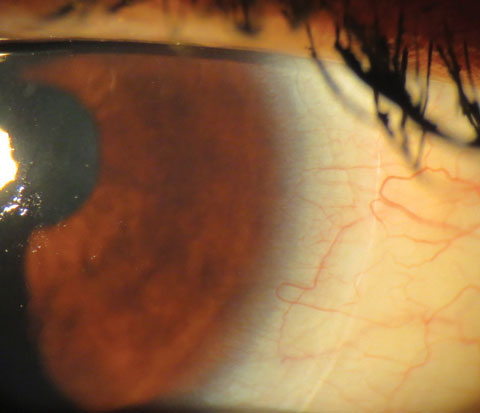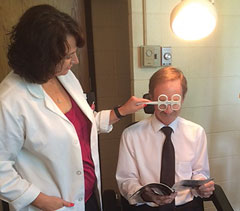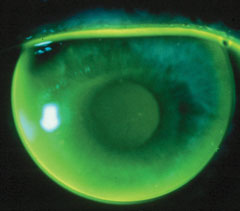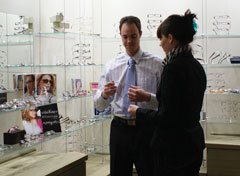It’s estimated that there are more than a billion presbyopes in the world. With this in mind, chances are, members of the over-forty crowd are sitting in your chair on a daily basis. And the landscape for presbyopic correction has never been broader. But if you’re ignoring multifocal contact lenses as a go-to for your presbyopes, experts say you’re missing the boat.
“I have witnessed many doctors not even bringing up contact lenses to their presbyopes,” says Justin Bazan, OD, of Brooklyn, NY. “It’s simply a bad habit of assuming that presbyopes, who are not there for a contact lens exam, are not interested. This is a huge missed opportunity.” In this case, optometrists should be asking every presbyopic patient, including previously failed wearers and those who have never worn contact lenses, “‘How come we’re not doing a contact lens exam as well today?’” Dr. Bazan says. “You will find that many of them have reasons that are easily overcome with today’s innovative contact lenses.”
 |
| Those looking for soft multifocal contact lenses have many options with today’s advances. Photo: Stephanie L. Woo, OD. |
The latest multifocal contact lenses are far more advanced than the previous generation and run the gamut from soft disposables that provide better day-to-day comfort, to new platforms such as hybrids and scleral lenses. Additionally, there are a variety of designs on the market that can allow a practitioner to customize the lenses by using multiple designs for patients, says Julie DeKinder, OD, director of academic programs and residencies, chief of contact lens services and associate clinical professor at the University of Missouri-St. Louis College of Optometry. These new options include center-near or center-distance lenses and a variety of add powers in soft contact lenses, Dr. DeKinder says. And, these lenses are available in all replacement modalities.
“The manufacturers have done most of the heavy lifting,” says practice management consultant Gary Gerber, OD, of the Power Practice. “The only barrier left is the doctor’s inertia.”
Here, your colleagues offer some pearls on how you can bolster multifocal contact lens sales in your practice, improving patient satisfaction and your bottom line.
Let’s Talk
One of the most effective, yet often underused, ways to get your presbyopes into multifocal contact lenses is simply bringing up this option during the exam, the experts say.
 |
| Dr. DeKinder uses loose lenses to perform an over-refraction binocularly while fitting a patient with multifocal contact lenses. Fitting specialty lenses can take more time, so be sure to charge an appropriate fee for your time and expertise. Photo: Julie DeKinder, OD |
“Most patients don’t realize that multifocal contacts even exist. It is up to the OD to recommend these to patients,” says Stephanie Woo, OD, of Lake Havasu City, Ariz. “Out of thousands of contact lens patients, only a handful have actually asked me about trying a multifocal lens. If I don’t take the initiative and bring it up as an option, they would never know.”
All presbyopes need refractive correction, but few-to-none are wearing multifocal contacts, with the majority of these patients opting for reading glasses or monovision for near vision, says Mile Brujic, OD, of Bowling Green, Ohio. This is mainly because optometrists are shying away from communicating the options to patients, he adds. “If a presbyopic patient says they are not interested in contact lenses, it’s good to understand why. If there are real limitations, or if a patient tried a multifocal contact lens six months to a year ago and it didn’t work, that’s one thing.” But optometrists are remiss if a patient says they tried a multifocal 10 years ago and it didn’t work without informing them about the advances in today’s designs and suggesting multifocal contacts as a viable option again, Dr. Brujic adds.
“I think we are reactionary when it comes to our presbyopes,” says Dr. Brujic. “We often feel that if we make a recommendation or offer a solution, and the patient says, ‘No, I’m not interested,’ we should simply stop offering it to all our other patients unless a patient comes in and specifically asks for it.” If a patient comes into the office and says they simply need correction for near vision, optometrists often make assumptions and suggest reading glasses or progressives or bifocals, he says. “We need to educate every presbyopic patient that there are contact lens options available to them as well.”
Optometrists need to have routine conversations with presbyopic patients on multifocal contact lenses and their benefits, Dr. Woo says. “Typically, I might say something like, ‘Andrea, right now you are having to wear cheaters on top of your contact lenses to see anything up close. Would you be interested in a contact lens that could limit your dependency on glasses?’ Many patients are intrigued at this idea and want to learn more.”
For Dr. DeKinder, the best way to build a multifocal practice is to start educating patients. During the exam, if the patient is a spectacle lens wearer, she will ask if they have ever thought about wearing contact lenses. “I will then educate them about their contact lens options and which lenses I believe will work best for them. I find this gives the patient something to think about. The patient doesn’t always want contact lenses, but after I educate them and let them know about the type of visual outcome they could have, they will think more carefully about their options,” she says.
 |
| If you fit patients well, such as with the aspheric multifocal gas permeable lens seen here, they’ll love the freedom from reading glasses you enabled for them. Photo: Edward S. Bennett, OD. Click to enlarge. |
For a patient who needs multifocal contact lenses but is a current distance-only contact lens wearer, Dr. DeKinder always discusses multifocal lenses. “I also encourage the patient to let me fit them with a multifocal lens by telling them they really have nothing to lose. If the multifocal works, that is great for them. If the multifocal doesn’t work, they can always go back to their current modality. However, I must say, it is rare that a patient will ever have to go back to their current modality.”
Lens Pricing and Setting Fees
One of the keys of multifocal contact lens sales is the annual supply, says Dr. Woo. Since multifocals generally cost more than traditional lenses, the patient may push back after hearing the price increase, she says. But there are some ways around this, she adds.
“Manufacturers have really helped this by offering great rebates when patients order an annual supply. Your office can show the patient how much they will save if they order an annual supply, and that can help overcome some of the price hurdles,” she says.
Although patient satisfaction is paramount when fitting multifocal contact lenses, they can be a huge revenue source for the practice as well, says Dr. DeKinder. “The fees for fitting specialty lenses are higher, the lenses are specialty and thus are priced higher; additionally, the presbyopic patient should always have a backup pair of progressive spectacles and a nice pair of non-prescription sunglasses,” she says.
Always separate professional and material fees to allow for comparative pricing, suggests Glenda Secor, OD, of Huntington Beach, Calif. Take advantage of all manufacturer incentives to stay competitive and don’t devalue your professional time, she adds.
 |
| Fitting patients into multifocal contact lenses doesn’t have to cut into your dispensary sales. Patients still need a backup pair of progressive spectacles and a nice pair of non-prescription sunglasses, Dr. DeKinder says. |
Advances in lens design are breaking down barriers, too. In light of higher patient acceptance of newer designs, “our success after the first visit is so high, we have set our fees for a multifocal contact lens design to our basic level,” says Dr. Bazan. “Chair time historically was much more for multifocal contacts, but we have found that not to hold true today for us.” If a multifocal contact lens fitting goes beyond the second visit, Dr. Bazan says his practice simply upgrades the patient to a higher fee. “Lowering the financial barrier may help get them into a multifocal contact. For us, it means that every patient who is a candidate for a multifocal contact gets to try at least one of them.”
Free In-Office Trials, Referrals and More
One of the best selling points for multifocal contact lenses is simply getting them on your patients’ eyes, Dr. Bazan suggests. “If it is an option, get the lenses on them. Get passionate about multifocal contacts. It’s contagious, and your patients will share in the excitement,” he says. Dr. Bazan also suggests letting the apprehensive patient try a free in-office trial while they browse for glasses. Often, they are so impressed, the patients will enthusiastically get the contact lens exam on the spot, he says.
Another marketing tip that has worked for Dr. Bazan is being aggressive about getting referrals. “Get their spouses in. I’ve found that the spouses are often excited and look forward to experiencing the lenses for themselves. Simply ask for the referral,” he says.
A television with a slideshow running in the waiting area that highlights specific lens designs is a great way to educate patients before they see the doctor, Dr. DeKinder adds. A simple question on the patient questionnaire asking if patients are interested in contact lenses gives the doctor another avenue to present lens options, she says.
Keep it Simple
Experts suggest that instead of describing the optics of multifocal contact lenses in minute, scientific detail to patients, keep it simple to avoid potential confusion.
“I tell patients, ‘We have a multifocal lens that can provide you more freedom from your reading glasses,’” Dr. Brujic says. “Often, when people hear ‘multifocal contact lenses,’ they think they’re going to have to tip their head back to get in the near zone. I tell them they won’t have to do that with these lenses. And I tell the patient, with multifocal contact lenses, they are going to have more peripheral vision and not be as constrained with their glasses.”
Get Your Patients Psyched!Optometrists today face enormous competitive pressures on the retail component of our practices, and rarely is this felt more acutely than in contact lens sales. But we all know buying is not just about getting the lowest price. There are many complementary factors—convenience, to name one—commonly discussed as influencers of buying decisions. However, I feel the factor that is most appropriate to understand, yet often overlooked, is the psychology of what gets people to say yes to the sale. It’s the notion that people who feel indebted to you after you have provided them with exceptional care and an extraordinary experience will return the favor, i.e., buy from you. What I’m talking about is known as “the Rule of Reciprocation.” This especially holds true when we blow away our patients’ expectations. At my practice, we are often able to do exactly that with the innovative multifocals that have recently been added to our repertoire. Surprisingly few optometrists offer multifocals routinely, and providing this service is an excellent way to showcase your expertise. In my experience, the enthusiastic and grateful multifocal wearer is least likely to even be thinking of shopping around, let alone to be driven by price. They are so thankful and pumped up they can’t wait to get their order in. This psychological factor is something that first came to me as I read a book about human behavior called Influence: The Psychology of Persuasion by Dr. Robert Cialdini. When you combine that realization with the tried-and-true methods of capturing the annual sale—i.e., optimal hand off, annual supply discount, doctor-only rebates, ready inventories—you can expect to enjoy a high in-office sales capture rate. Thinking that we can compete on price with the 1-800s of the world is a delusion that leads many practitioners astray. That’s a race to the bottom we simply cannot win. Results will be better for patient and practitioner alike when we aim high. —Justin Bazan, OD, Park Slope Eye, Brooklyn, NY |
When striving to keep it simple, let the lenses do the talking, Dr. Bazan says. “Keep the initial information brief,” he says. “I simply reassure the patient that they are going to love them. I have found a lot of questions are from a patient’s apprehension, but often a doctor’s explanation leads to even more apprehension.” Much of this stems from the doctor’s previous experience with older multifocal technology, he adds.
Let Staff Be Your Ambassadors
Look no further than your staff as advocates for multifocal contact lenses at your practice, Dr. Brujic says. Those who are candidates for multifocals should be given lenses to try so they can share their experiences and success stories with your patients.
Staff at Dr. Brujic’s practice also helps in marketing the lenses by watching patients’ body language. “A tech or staff person may notice during the pretest that a patient is putting on and taking off their glasses to perform certain tasks, or that they are tipping their head back and looking at objects in the near portion of their progressive lenses. When we see this, we can actually offer these patients an opportunity with multifocal lenses to be free from having to do these things on a daily basis,” Dr. Brujic says.
Timing is Everything
At Dr. Bazan’s practice, he has found the best successes in transitioning a presbyope into multifocal lenses is to not test out vision until the patient has had a minimum of 15 minutes of neural adaptation. “I have them spend the first five minutes looking out the window people watching, the next five minutes trying on sunglasses and the last five minutes using their phone. Then I ask them what their experience was like. If they love the lenses, shut your mouth. Don’t sabotage the experience by bringing up past experiences you had with previous patients who were probably in less innovative designs, and consequently, had less than stellar experiences. If they are having a great experience, let them enjoy it.” Then, Dr. Bazan suggests optometrists reinforce how well the patients are doing in their lenses and let them know their experiences should only continue to get better. “VAs are important, but you don’t have to immediately put up the 20/10 line and push them. In fact, don’t.”
It takes staff and chair time to explore new modalities such as multifocal contact lenses with patients, but the time necessary to fit and follow a potentially successful patient will benefit both the patient and doctor in tangible and intangible ways, Dr. Secor says. “Don’t miss an opportunity to be successful,” she says.
Dr. Gerber’s final piece of advice: “Pretend monovision and readers don’t exist. Seriously, it’s a great way to start changing your thinking.”
